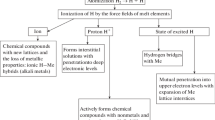Abstract
Hydrogen solubility in pure iron and iron based binary alloys have been measured in the temperature range 20 to 500° C under hydrogen at atmospheric pressure. For pure iron, hydrogen solubility decreases as the temperature decreases until about 300° C and then increases reaching maximum at 80° C. The maximum solubility at this temperature was about 0.9 ppm. This large value is thought to result from chemisorption of hydrogen at the grain boundary. The addition of alloying elements, Mo, W and Ni increased the temperature at which hydrogen solubility had its maximum and had no other effects on the trend of hydrogen solubility change as a function of temperature for pure iron. The higher heats of chemisorption of hydrogen onto Mo and W compared with Fe may be responsible for the change in temperatures. Other possible methods of trapping hydrogen in iron and iron based binary alloys are discussed.
Similar content being viewed by others
References
L. S. Darken andR. P. Smith,Corrosion 5 (1949) 1.
D. M. Allen-Booth andJ. Hewitt,Acta Met. 22 (1974) 171.
M. L. Hill andE. W. Johnson,Trans. AIME 215 (1959) 717.
R. Gibala,ibid. 239 (1967) 1574.
R. A. Oriani,Acta Met. 18 (1970) 147.
M. A. Whiteman andA. R. Triano,Phys. Stat. Sol. 7 (1964) K109.
J. F. Newmann andL. L. Shreir,J. Iron Steel Inn. 207 (1969) 1369.
J. Chipman, “Basic Open Hearth Steelmaking”, (American Institute of Metals and Engineering, New York, 1951) pp. 640–724.
W. Geller andT. H. Sun,Arch. Eisenhuttenw 21 (1950) 423.
J. P. Hirth andB. Carnahan,Acta Met. 26 (1978) 1795.
R. A. Oriani, Proceedings of the Conference on Fundamental Aspects of Stress Cracking, 1967, Columbus, Ohio, National Association of Corrosion Engineers (Stoeh Leed, Houston, 1969) p. 32.
H. S. Taylor,J. Amer. Chem. Soc. 53 (1931). 578.
J. E. Werner andH. M. Davis,Trans. ASM 53 (1961) 853.
A. W. Adamson, “Physical Chemistry of Surfaces”, (John Wiley and Sons, New York, (1976) pp. 522–62.
J. J. Bikerman, “Surface Chemistry”, (Academic Press, London and New York 1958) pp. 301–67.
W. Eichenauer, H. Kunzig andA. Pebler,Z. Metallk. 49 (1958) 220.
Author information
Authors and Affiliations
Rights and permissions
About this article
Cite this article
Choo, W.Y., Lee, J.Y., Cho, C.G. et al. Hydrogen solubility in pure iron and effects of alloying elements on the solubility in the temperature range 20 to 500° C. J Mater Sci 16, 1285–1292 (1981). https://doi.org/10.1007/BF01033843
Received:
Accepted:
Issue Date:
DOI: https://doi.org/10.1007/BF01033843




